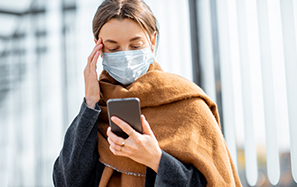Based on all the studies I've read, I offer my best guess of the importance of various infection routes and how to minimize their risks. I believe this best guess improves our ability to combat the virus and preserve our society.
Lees volledig artikel: A first step towards quantifying the influence of the aerosols
A first step towards quantifying the influence of the aerosols
The WHO’s snail rate
The key question is not whether or not airborne contamination takes place, but what part of all contamination that is. It will be clear that the WHO/CDC and others, who at first found the airborne infection of little or no importance, are now at most willing to acknowledge that it may have some importance. But it’s not very important and it should and will only be a small part.
Just look at what’s in the Q&A since a few days on the WHO site:
To bring tears to your eyes. So this is what the WHO says 5 months after the biggest global outbreak of a virus in contemporary history. It strongly resembles the reactions in the Netherlands of most virologists and epidemiologists. They remain, at least in public, close to the point of view of WHO/Dutch CDC
Influence
The central problem in the discussion about the influence of each of the forms of infection is that all the studies I have come across provide only partial evidence. Where one only sees what one wants to see…
This is also so nicely illustrated by the statements of RIVM (Dutch CDC) and Prime Minister Rutte: In their advice it literally says: “The measures taken are aimed at avoiding virus transmission through large drops, and the measures have an effect. If coronavirus were to spread aerogenic, the 1.5 metre distance measures would have had no effect”.
One forgets that several measures have been taken. Such as banning meetings. It could be that they also played a role or even the most important role or maybe even the only role.
My conclusions
Precisely because, as an outsider, I tried to explain the patterns of spread of the virus through data analysis, I had no preconceived or outspoken ideas about the forms of infection. I all felt that the patterns found simply didn’t fit the mere spread of the virus through larger drops and objects.
And I soon saw in several studies that there were several infectious diseases where the infection was purely airborne. But also that for a long time there were scientists who pointed out the airborne spread of influenza. Like (1), (2) and (3). And also with SARS in 2003 this has been claimed by quite a few scientists. (4 , 5).
The most striking was this find on the Dutch CDC website under the Influenza guidelines.
The lower respiratory tract is the most susceptible to infection, while the preference for upper or lower respiratory tract may vary depending on the subtype of influenza A virus. The minimum dose of infection via aerosols that can enter the lower respiratory tract is very low, in the order of one or a few virus particles. Experimental infection by dripping virus into the nose requires a hundred times more virus, so we assume that infection by droplets and infected hands or objects (doorknobs, telephone horns, keyboards) plays a smaller role.
Drop
COVID-19 also strikes mainly in the lower respiratory tract (the lungs). Why, with this knowledge about influenza on the RIVM website, people are sticking so rigidly to the spread of Covid-19 via a larger drop, I cannot get out of the foundations of the WHO or RIVM.
Over the years this discussion has resembled a battle of faith (as between Catholics and Protestants) rather than a scientific discourse. In my opinion, science was the main victim at first. But now the whole world suffers with colossal consequences, as we have already seen in recent months and will see in the years to come with even greater damage.
Unfortunately, therefore, I am not too optimistic about the way in which the WHO will move towards the degree of importance attached to aerosol contamination. Take another look in Northern Ireland to see how Catholics and Protestants still face each other today.
I have just stumbled upon a new study, which gives me more direction in estimating the importance of the different forms of contamination, which points even more to the great importance of the aerosol contamination compared to the contamination via the droplets.
At the end of this piece, you will find these figures.
Before I discuss that study, I briefly describe what I think are the most important findings regarding the distribution of Covid-19, which I have come across in recent months and described in my blogs. You can find them via the table of contents and the search option on this site.
- A very large part of the infections in the world took place before the lockdown via super speech events.
- Covid-19 largely follows the spread pattern of influenza around the world.
- In houses with a patient, significantly fewer roommates were infected than you would think, based on the assumed danger of infection within 1.5 meters and through objects.
- Based on the patterns of spread and the studies carried out, the chance of being infected with Covid-19 via surfaces is virtually zero.
- If you are infected at a superspread event, you will have significantly more symptoms than if you are infected at home. And there are also far fewer people without symptoms.
- A large part of those with antibodies in the blood have experienced no symptoms.
- If you get the virus into your nose through drops, it doesn’t automatically mean that someone will get infected for sure.
- If you get the airborne virus into your lungs through inhalation, you will be sicker than if it gets into your nose through a drop.
- In all situations a minimum number of virus particles is needed to become infected or ill. (“Viral load”).
The ratio between infection via larger droplets and via aerosols
So the key questions are:
- How does the virus get into anyone? It’s different with different viral diseases. (HIV is very different from influenza). There are only a few places on/in the body, where that leads to an infection.
- If it has entered the “right” place then it doesn’t mean that you will definitely be infected by it. It is mainly about the amount of the virus and the way your body tries to remove it. There are several methods for that.
- And if you do get infected, the question is how sick you get from it. There are people who don’t notice it (asymptomatically) and people who get very sick of it and die. Unfortunately we don’t know the real percentages yet and they depend very much on the age of the infected person. But worldwide we now come across figures that are somewhere between 0.1 and 0.5%.
So it’s about the ratio between the infections via larger droplets and via aerosols.
A recent study provides very important information in this respect: This is the summary of the results:
The main results of this study are, as it is described above the article:
- The smaller the exhaled droplets are, the more contagious the short distance airborne route is.
- The speed of ejection has a significant influence on the distance a droplet travels and the change in its size.
- The large drop route is only dominant if the persons are within 20 cm of each other when speaking, or 50 cm when coughing.
- The large droplet route only contributes 10% to exposure if the droplets are smaller than 50μm when people are 30 cm apart face-to-face.
This too is a study based on a model with certain assumptions. After all, how many viruses do the droplets with different sizes contain? Is one infected or not if one gets that drop and how many viruses are then minimally needed? But it is in any case a more solid foundation than I have found so far about the large drops and the 1.5 meters.
How much virus
However, this other study is the first to attempt to quantify how much virus you need to ingest via aerosols to get infected. This depends on the number of virus particles in the air and the duration of inhalation. The key concept here is “quanta”. It is a complex matter, but if you read the study it is good news that with aerosols you don’t get infected after one or two breaths. It depends on how many aerosols there are in the air and how long you are in that environment. This study shows that in many cases it can take much more than ten minutes.
With all this I found this extensive source about forms of diffusion and the importance of aerosols very instructive (it may be more than 10,000 words, but if you have time I would really read it).
Finding the right balance
The big challenge for the world is, on the one hand, to ensure that as few new people as possible become seriously ill as a result of this virus and, on the other hand, to reduce the damage to society (economy, social, public health, etc.) to zero.
Unfortunately, a balance is always needed. Through a complete lockdown, as few new people as possible will become seriously ill, but the damage to society is colossal.
With regard to all kinds of risks in our society we make such a balance. We have more than 600 road deaths in the Netherlands. If we lower the speed limit to 30 km/h on motorways, the number of deaths will decrease by, let’s say, 200.
So by maintaining 100 km/h as the speed limit, we accept those 200 extra fatalities. Or we give people room to smoke, while the number of deaths is therefore estimated at – much more than – 10,000 per year.
We now realise that national lockdowns cause far too much damage. Even local lockdowns should be avoided. But it is also necessary for citizens to be able to properly assess what risks they really run and where those risks are. Because otherwise, their behaviour will be (severely) restricted, with adverse consequences both for themselves and for society (economic, social and public health).
Risk
For smart measures, we will need to know how people can really be infected, how high the risks of infection are in various locations and what can be done to reduce those risks. Both on an individual level and in terms of environmental factors.
The attitude of the WHO/RIVM is that it is almost exclusively done through large drops and direct contact. Keeping a distance of 1.5 meters, washing your hands and coughing in your elbow is not only one-dimensional, but is not supported by empirical research. More and more research shows that there is much more going on.
In order to be able to keep that up, WHO/RIVM can only state that people, if things go wrong again, have not kept the 1.5 meter distance. (The ultimate circular reasoning).
This one-dimensionality is in my opinion the reason that the virus is not under control worldwide. And that in Europe, somewhere between October and December, the virus is going to strike again in the same way as it does now in Melbourne. While a month ago in that state of Victoria only a few new cases per day were discovered, this has already risen to 300. This has created a lockdown of the entire state with more than 6 million inhabitants!
Fighting the virus
Based on all the studies I’ve read, I’m giving scientists a “best guess” of the importance of the different forms of infection and how to minimize the risks.
I think that with this “best guess” in the world, we will make a lot of progress in fighting the virus and maintaining our society.
I hope for a better version of this “best guess” based on the input of experts with an open mind for all that is available. So not based on biased positions. After all, we know only too well how that went for centuries with the struggle between Catholics and Protestants.
My best guess is:
- 75% of all infections happen at so-called super-spread events. These are gatherings where 5 or more attendees are infected. They take place in closed rooms with little or no fresh air. This also includes infections that pass through an HVAC system, in which the virus particles are spread over all areas of the building/complex. I estimate that more than 99% of these contaminations occur via aerosols.
- The other infections take place per person, as it were. (With sometimes more than one at a time). This can be done in three ways:
o You get a drop of an infected person in your nose/mouth/eye. This can happen with coughing/sneezing and talking, but only at a very short distance.
o If an infected person coughs / sneezes / talks and you are at a short distance, you breathe in the aerosols for a while, which are released during the coughing / sneezing / talking.
o You spend some time alone or with a small number of people in a room where aerosols have been released into the air by that one patient, and you become infected.
Of course, in care situations (hospitals, care centres) the above occurs relatively more often than in a normal home situation.
My best guess for these three variants (i.e. based on the number of people infected) is:
- Via a drop of an infected person in your nose/mouth/eye I estimate 2%.
- By breathing in aerosols at a short distance for a while I estimate 8%.
- By breathing in aerosols for a while I estimate 15%.
Based on this best guess I will come up with a document one of the coming days, where everyone can read what to do in specific situations based on the actual risk and the risks you are willing to run.
This is much more than the 1.5 meter doctrine, as I have already shown in this piece.
You have just read: A first step towards quantifying the influence of the aerosols.









